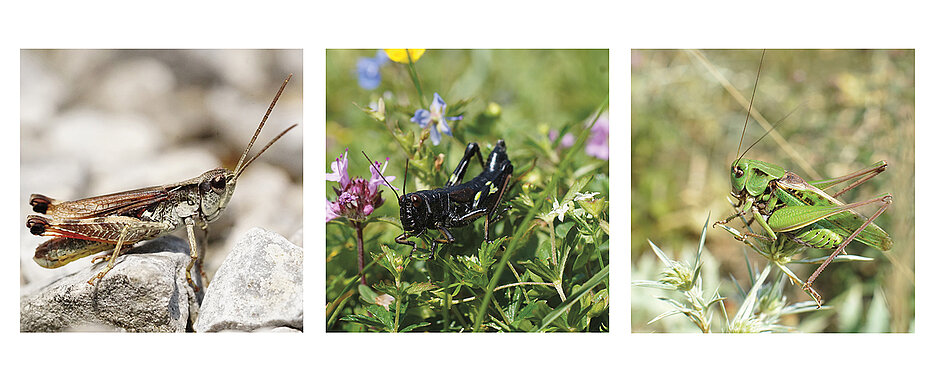Little is known about the food webs of herbivorous insects. A team from the Würzburg Biocenter is investigating, in Lower Franconia as well as in the Berchtesgaden Alps.

Anyone walking past a meadow on a mild summer evening is often exposed to an impressive concert. It is the grasshoppers, bush crickets and crickets that create a Mediterranean atmosphere with their chirping. The songs are usually those of males trying to attract females to mate with them. But they can also be rival songs when two males get too close to each other.
In total, there are more than 80 species of Orthoptera in Germany. "Grasshoppers are very important for many open grassland ecosystems", states zoologist Sebastian König from the Biocenter of the Julius-Maximilians-Universität (JMU) Würzburg in Bavaria, Germany: "The insects are an important food source for birds. And as herbivores, they remove up to 30 percent of the plant biomass in a meadow, thus promoting the co-occurrence of many plant species."
Climate change: How do food webs respond?
Grasshoppers and their feeding habits are a scientifically exciting topic. Generally, there is still a need for research on the feeding interactions that link plants and herbivorous insects.
Why are scientists interested in this? "It is important to understand how food webs function in order to be able to predict their stability in the context of climate change", explains König, who is a doctoral researcher at the JMU Chair of Animal Ecology and Tropical Biology headed by Professor Ingolf Steffan-Dewenter and co-supervised by Professor Jochen Krauß.
More than 3,000 grasshoppers observed
König and colleagues from Würzburg, Munich and Salzburg have published a first contribution to the understanding of Orthoptera-plant interactions in the journal Global Change Biology.
For the study, Orthoptera-plant communities were investigated in different regions - at warm sites near Karlstadt and Winterhausen in Lower Franconia as well as in the Berchtesgaden Alps, hence allowing the analysis of species communities along a climatic gradient, at altitudes ranging from 250 to 2,100 metres.
During the summers of 2019, 2020 and 2021, the team determined which grasshopper species fed on which plants on 41 grassland sites. They observed more than 3,000 individuals of 54 species and collected the faecal pellets of the animals to analyse the plant remains they contained using DNA sequencing.
Theory on food niche partially confirmed
The ecologists wanted to test the hypothesis put forward a few years ago that it should be advantageous for insects at higher altitudes to feed on a broader range of plant species. This would make sense, because in high alpine environments the choice of food plants is limited. Therefore, and because of environmental variability, it is advisable not to be too choosy there.
König's study partially confirms the hypothesis. It shows that grasshoppers eat a relatively wide range of plants in cold regions. However, this also applies to warm habitats, such as the calcareous grasslands of Lower Franconia. In temperate habitats, on the other hand, where the number of plant species is large, grasshoppers are more specialized, thus feeding on plants that are closely related. But resource composition also plays an important role for the herbivores. For example, grasshoppers with a preference for grasses dominate in meadows with a high proportion of grasses.
The researchers' conclusion: "Our results suggest that climate and plant community composition influence the dietary specialisation of herbivores. If herbivores devour many different species, this could be an adaptation and a prerequisite for being able to survive in climatically extreme habitats."
Now the microbiome of the grasshoppers is being analysed
The JMU scientists now want to gather even more facts about the food niche breadth of herbivorous insects. Next, they will analyse the microorganisms that live in the gut of the grasshoppers. In this way, possible relationships between the diet and the diversity and composition of the microorganisms will be uncovered.
The Bavarian State Ministry of Science and the Arts funded this study as part of the "Excellence Networks and University Cooperations" programme.
Publication
Phylogenetic relatedness of food plants reveals highest insect herbivore specialization at intermediate temperatures along a broad climatic gradient. Sebastian König, Jochen Krauss, Alexander Keller, Lukas Bofinger, Ingolf Steffan-Dewenter. Global Change Biology, 16 April 2022, DOI: 10.1111/gcb.16199






